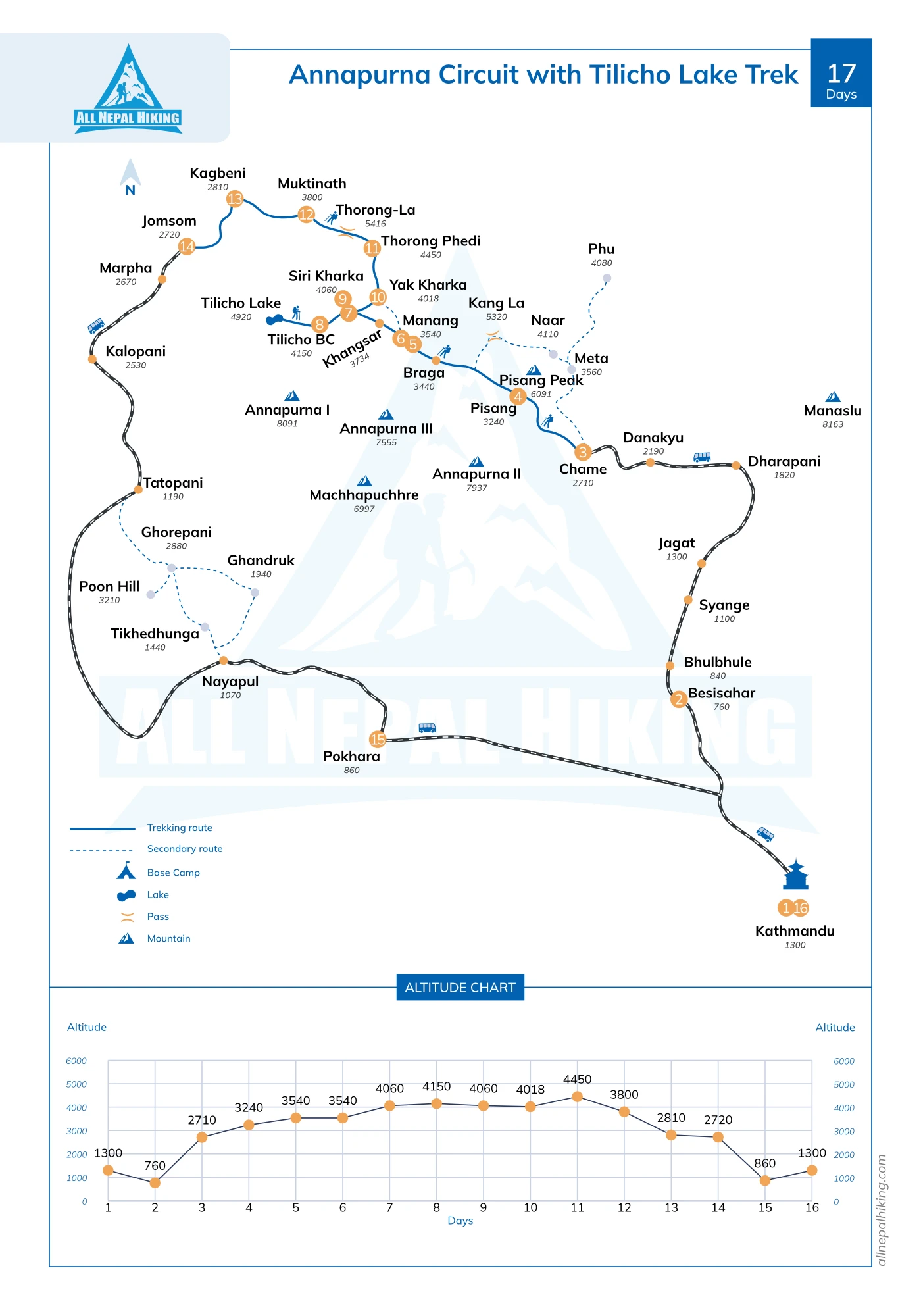The Annapurna Circuit Trek including Tilicho Lake is one of Nepal's most popular and hardest treks, lasting around 19 days. The trek combines the traditional Annapurna Circuit walk with a visit to Tilicho Lake, one of the world's highest lakes. The trip begins at Besishahar and continues through beautiful woods, terraced farms, and traditional villages along the Marsyangdi River valley. The environment changes as you ascend, and you will meet more difficult terrain and lovely alpine woods. The path also provides breathtaking vistas of the Annapurna massif, including Annapurna II, III, and IV, as well as Gangapurna and Tilicho Peak. You will travel to Tilicho Lake at a height of 4,919m/16,138ft after traversing the difficult Thorong La Pass (5,416m/17,769ft), the highest point of the expedition. The lake is revered by Hindus and Buddhists for its pure beauty and breathtaking mountain vistas.
The trek then continues to Jomsom, where you can take in the breathtaking vistas of the Kali Gandaki valley and explore the old settlement of Kagbeni. From Jomsom, you may either hike to Muktinath, a Hindu and Buddhist holy place or take a vehicle to Jomsom. The trek ends with a drive to Pokhara, where you may rest and enjoy the gorgeous lakeside city. Overall, the Annapurna Circuit trek with Tilicho Lake is a difficult journey that needs a high degree of physical fitness and acclimatization. It's critical to have the right gear and equipment for the expedition, as well as a trustworthy guide and porter, to ensure your safety and pleasure of the adventure.
The Tilicho Lake and Annapurna Circuit treks introduce you to charming villages inhabited by diverse ethnic groups, all while offering breathtaking panoramic views of the majestic Himalayas. Our itinerary has been tailored to match the Annapurna Circuit route, with a slight variation. Instead of heading north to Tanki Manang and Yak Kharka from Manang, this route veers westward through the main valley. It takes you through the captivating Khanshar Village, which marks the last settlement in Nepal. Continuing onwards, the trek ascends to the stunning Tilicho Lake. From there, the journey proceeds to Yak Kharka and eventually culminates at the Thorung La pass, towering at an elevation of 5,416 meters.
Difficulties of the Annapurna Circuit Trek with Tilicho Lake Trek
The Annapurna Circuit with Tilicho Lake trek presents significant challenges. Trekkers are required to hike for approximately 7-8 hours on average each day, enduring high-altitude conditions for over two weeks. Mitigating the risk of altitude sickness involves acclimatization, hydration, and gradual ascent. The trekking route encompasses steep ascents and descents, leading through various natural terrains like alpine forests, glacial lakes, mountain passes, and deep gorges. The demanding terrain, along with the constant elevation changes, poses challenges for trekkers of all levels of experience. This remarkable journey demands both physical and mental readiness, considering its extended duration. Accommodations and food are basic, necessitating some compromises. While technical skills are not imperative, the trek demands a considerable amount of physical strength and endurance.
Trekkers must possess good physical fitness and stamina, with prior hiking experience being advantageous. Adequate training and exercise, undertaken for two to three months or at least two weeks before the trek, are essential. This training regimen should encompass aerobic activities such as hiking, swimming, jogging, cycling, etc., to enhance your preparedness for the trek. In conclusion, the Annapurna Circuit with Tilicho Lake trek is undoubtedly challenging, but proper preparation and planning can ensure a more comfortable completion of the journey.



 based on 11 reviews
based on 11 reviews
